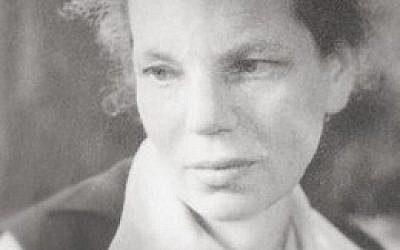
Dr. Gertrud Luckner (born Jane Hartman) was a singular heroine of the Holocaust. She resisted Nazism and played an instrumental role in reaching-out to many Jews, either by actually rescuing them or by assuaging their bitter plight. .
She passed away on August 31, 1995, 25 years ago and I would therefore like to share with the readers the awe-inspiring legacy of this unique human being.
She was born on September 26, 1900, in Liverpool, England, to German parents and from the age of 6 she moved to Germany.
She had no siblings and lost her parents at a young age. When she became an orphan, she was sent to a foster family who changed her name to Gertrud Luckner.
She excelled in her studies and eventually, in 1938, she obtained a PhD degree in Social Welfare Economics from the University of Freiburg.
When the Nazis came to power in 1993, she was already involved as a social worker in the German Catholics Peace Association and in Caritas. She was born and raised as a Quaker but around that time she decided to embrace Catholicism.
As the hostilities against the Jews dramatically intensified, Gertrud became more active in Caritas, securing safe passage to Switzerland to a number of Jews. She also organized a network of aid for the persecuted, sending food parcels and clothes to others who were interned in Nazi camps.
With the backing of the Archbishop of Freiburg, Conrad Grober, she went one and set-up within Caritas a Religious Relief Bureau for the victims of the war and she orchestrated her life-saving campaign from there.
Her relief effort was supported with funds provided by Archbishop Grober and she not only smuggled Jews into Switzerland but also kept a direct channel of communication with the outside world, divulging the suffering of the Jews. She also closely cooperated with Leo Baeck, the Leader of the Jewish community in Germany.
The Gestapo was monitoring her activities through a net of informants and in March 24, 1943, she was arrested, accused of being a “Catholic activist” and an “enemy of National Socialism”. After weeks of harsh interrogation, she was sent to Ravensbruck concentration camp.
Fortunately, she managed to survive and after the war, she went back to her social work, helping the refugees and devoting herself to fostering a brotherly dialog between Christian in Jews.
In 1951, she visited Israel, becoming the first German citizen to be officially invited to the Jewish state. .
In an interview she gave to acclaimed researcher and author, Elizabeth Petuchowski, Gertrud Luckner stated that her driving force was “ecumenism” (a term which at that time was not yet coined by religious authorities). She understood the plight of others and her vital method of reaching-out was “von Mensch zu Mensch” (from person to person). When asked why she did what she did, Dr. Luckner simply replied: “But that was obvious. That was obvious to me”, adding that “You must always comfort them (the victims). The only thing I can do is walk the way together with them…that is thinking the obvious. The whole thing had been so terrible – the deportations, one city after another – so that it really did not much matter anymore what happened to me“.
On February 15, 1966, Yad Vashem recognized her as Righteous among the Nations.
As founder of the International Raoul Wallenberg Foundation, an NGO devoted to preserving and divulging the legacy of the rescuers, I have come across hundreds of self-testimonies given by righteous heroes from various nationalities, religions and walks of life. Amazingly, most of them, when asked the same question – “Why did you save people“, answered almost an identical answer: “That was obvious” or “I couldn’t stand idly-by“
People like Gertrud Luckner have taught us that one person can make a difference.
 Gertrud Luckner (Photo: Gedenkstatte Deutscher Widerstand)
Gertrud Luckner (Photo: Gedenkstatte Deutscher Widerstand)
Her story should be spread-around, especially amongst young people, in order to instill her goodness in their hearts and minds.
